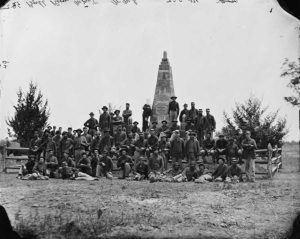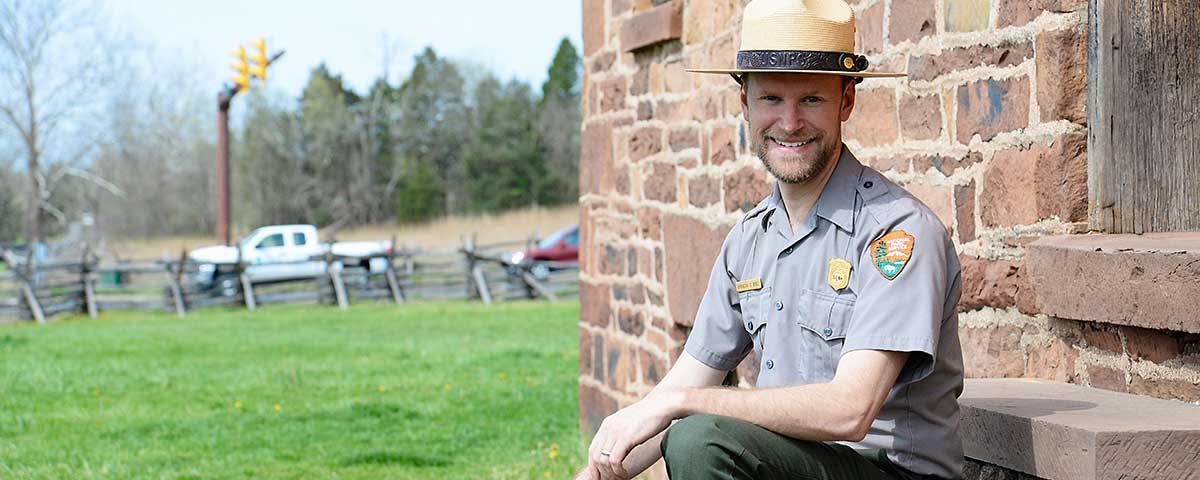
Brandon Bies, the new superintendent of Manassas National Battlefield Park, began his career as an archaeologist 16 years ago at Monocacy National Battlefield. He moved on to increasing levels of responsibility at a number of NPS sites, including George Washington Memorial Parkway, Great Falls Park, and Arlington House, where he shepherded the $12.3 million donation from philanthropist David Rubenstein for the restoration and interpretation of that site. Now at Manassas, he manages issues ranging from too many deer to landscape restoration and land acquisition.
CWT: What is your biggest challenge interpreting Manassas?
BB: We are in a very urban area with a tremendous amount of development. A lot of people see this as 5,000 acres of open space, and that’s not a bad thing. They see this as a place to recreate, walk their dogs, jog. We have the opportunity to embrace that while sharing the important American history that happened here. One of my greatest challenges will be striking that balance between recreation and respect for these hallowed grounds. We want people to come to the park.
CWT: What would attract someone who doesn’t have a strong connection to the war?
BB: The themes of freedom, civil war, conflict—that is not an unfamiliar thing to a lot of more recent immigrants to this country. So even though their great-great-granddad did not fight here, that’s still something we can emphasize to help them make that link.
CWT: So is interpretation here changing?
BB: It is changing. And we need to change it more. When the visitor comes here, they will learn primarily about the First and Second Battles of Manassas, or Bull Run. There’s much more we can tell, the stories of free and enslaved African Americans who lived here, the story of women who were heads of households or widows like Judith Henry, of the Henry House. These are stories we need to be telling to get those visitors here.
CWT: What has been the biggest surprise?
BB: We have a number of applications to run competitive races through the park. How do you balance recreation with respect for the battlefield? In an area of the park called Brownsville, we have a large picnic area, where not a lot of fighting took place. We try to push recreational activities there.
CWT: What is the park’s best kept secret?
BB: I think visitors learn much more about First Manassas than Second Manassas. Now we’ve opened up the Brawner Farm Center nine months of the year to focus on the story of Second Manassas. My vision longterm is maybe you don’t go to one visitor center for one story and the other visitor center for the other story. That these can be interwoven. Both the battles were the largest engagements in the Western Hemisphere at the time they were fought. There were about 100,000 people at Second Manassas.
CWT: What impact did these battles have?
BB: Both battles were significant Confederate victories and they legitimized the Confederacy in the eyes of other nations. First Manassas made it very clear this was not going to be a one-off. Second Manassas was downright frightening. If you read some of the diaries and letters of the soldiers who were in the battle or were stationed at the defenses of Washington, they were terrified. They thought that in a matter of a few days, the entire Confederate army would march into Washington.
CWT: What prepared you for this job?
BB: I’ve managed cultural resources, historic structures, the cultural landscape. I spent several years studying those and preserving those for the NPS. Then I spent some time as acting site manager for Great Falls Park, and this was a largely natural resource park. Then I went to Arlington House—very visible, very significant, very layered stories, with connections to George Washington and the huge enslaved population that was there. A complicated story, and a highly visited site in a very small space. So I learned a lot about working with other partners and neighbors, and inter-government relations.
CWT: The most misunderstood feature of Manassas?
BB: Some people ask why it’s not like Gettysburg or Antietam where there are monuments all over the place. Some like it more this way, the landscape is more pristine. We have a couple dozen monuments. Unlike other major battlefields that were owned by the War Department and turned over to the National Park Service in 1933, Manassas was entirely private property until 1940.
[quote style=”boxed” float=”right”]The Battlefields encompass about 5,000 acres[/quote]
CWT: Why wasn’t this owned by the War Department at the time?
BB: I don’t know. It was the site of two major Confederate victories. The core of the battlefield, including Henry Hill, was owned by Confederate veteran and hereditary organizations and it was known as the Manassas Battlefield Confederate Park. We still have a relationship with the United Daughters of the Confederacy.
CWT: What do you need to be a superintendent?
BB: You need to be externally aware, a good communicator, both internally and externally. You need to be a good listener. It is critical to be able to balance the big picture with day-to-day operations and internal and external issues. One of my priorities is landscape restoration and having a voice in respect to external pressures. Internally, we have a park partner, the Manassas Battlefield Trust, they support us both financially and programmatically. And the Civil War Trust is a huge partner in terms of land acquisition.
CWT: What problems do you face managing the landscape?
BB: A previous superintendent removed trees in an area where tremendous fighting occurred, to restore the Civil War landscape. Now the problem is maintaining it. It’s fairly rocky land, so mowing won’t work. You need creative solutions. We’ve talked about goats, and I’m looking at controlled burns. There is an issue of unexploded ordnance, but archaeologists can go in and sweep it first. Once we clear it, then we would go in and do a controlled burn every few years.
CWT: You have an enormous traffic problem.
BB: Visitors can struggle to experience the battlefield because of the traffic. We have been mandated by Congress to build a bypass around the battlefield and get the traffic out. We have a phenomenal landscape, but we have a major interchange where 12-13 percent of the vehicles are trucks. We have two quarries adjacent, and the Stone House, a historic tavern that was used as a Civil War hospital, is being damaged from the vibrations of commercial trucks.
CWT: How big is Manassas?
BB: The battlefields encompass about 5,000 acres—just under half of our acreage is open grasslands, we do hay leases. The park provides important habitat too. I’ve had some pretty special moments going out to the park and being up on a ridge somewhere and every bit of green that you can see is preserved by the NPS for everyone, for whatever they can connect to. ✯
Interview conducted by Senior Editor Sarah Richardson





